Encoder (Timing) Strip
The timing strip is a clear, plastic strip approximately ¼" in height positioned horizontally across the center of the unit, just in front of the carriage drive belt. The timing strip contains many thin black vertical lines that help determine the carriage position during operation.
During certain uncommon tasks such as the removal of a paper jam, it is possible to inadvertently touch a lubricated area on the printer's chassis causing a small amount of grease to be deposited onto the timing strip.
Grease on the timing strip may result in poor print quality including; mis-aligned or distorted characters, vertical lines or, in some cases, an inoperable error condition or knocking / grinding noise.
In most cases, it is easy to remove the grease from the timing strip using common household items. If you wish, you may follow the steps below to remove the grease from the timing strip.
Items needed:
• Clean, unused cotton swab
• Small amount of Isopropyl Alcohol or window cleaner
• Flashlight or other light source
Note: The illustrations will display a PIXMA MP620; however, the parts and cleaning procedure will be the same for your model.
- Power on the printer and open the main access cover (scanning unit cover).
The Print Head Holder (carriage) will move to ink changing (center) position.
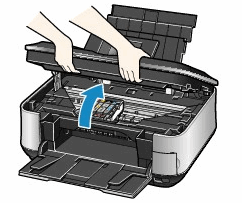
- With the access cover open, unplug the power cord from the wall outlet or power strip. Be sure the printer's power LED is no longer illuminated. This will allow you to easily slide the carriage left to right.
- Gently slide the carriage to the right side of the printer until it stops.
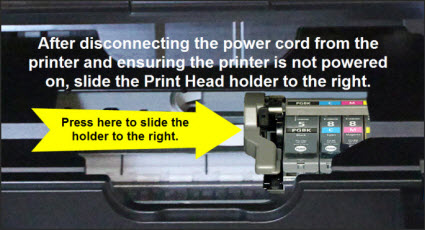 |
Carriage is centered
|
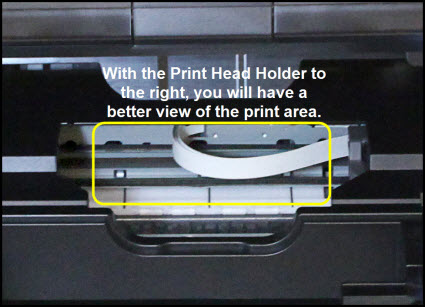 |
Carriage is to the right
|
- Using a flashlight, carefully inspect the timing strip for grease that may have attached to the timing strip. It is helpful to view the timing strip from several angles as even a small amount of grease can impact print quality.
Note: The timing strip is in front of the carriage drive belt.
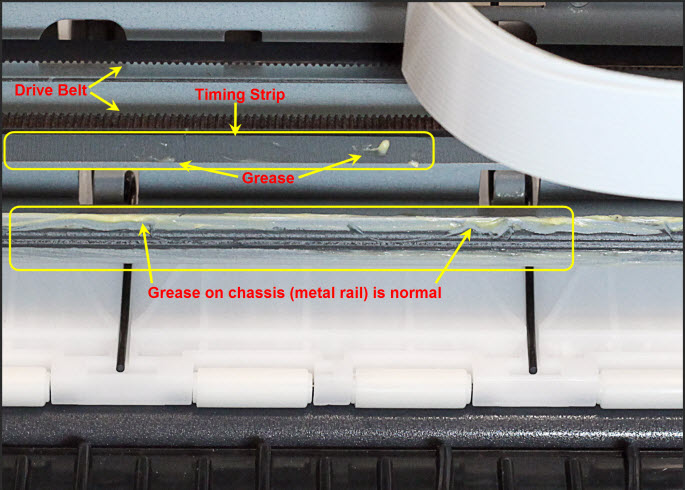
- Moisten the cotton swab with Isopropyl alcohol and carefully remove the grease from the timing strip. To prevent further spreading of grease, be careful not to touch the chassis or other areas inside the unit which may contain grease from the factory.
Note: If Isopropyl Alcohol is not available, you may use window cleaner solution.
CAUTION: Do not remove the grease on the chassis (metal rail).
- Once you have confirmed that the left and center portions of the timing strip are clean, gently slide the carriage all the way to the left until it stops.
- Repeat steps 4 & 5 for inspecting the right side of the timing strip until is completely free of grease and other matter.
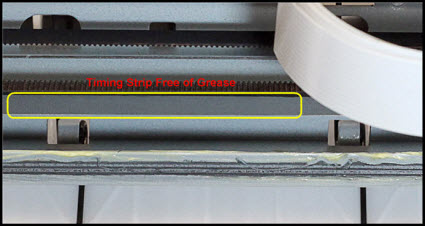
- Lift the scanning unit support and then close the printer's main access cover.
- Reconnect the power cord and power on the printer.
(The indicator light blinks steadily while the printer initializes.)
- Confirm operation of the unit by printing a photo or other print sample such as a Nozzle Check Pattern. If print quality is still poor, repeat the above steps.
(e.g. A nozzle check pattern can be printed via the printer's menu (Settings > Maintenance > Nozzle Check Pattern). Otherwise, select "Nozzle Check" pattern from the maintenance tab of the printer driver properties on your computer.
Nozzle Check Pattern:
-
Make sure that the machine is powered on.
-
Load one or more sheets of A4 or Letter-sized plain paper in the cassette.
-
Open the Paper Output Tray gently, and open the Output Tray Extension.
-
Print the nozzle check pattern.
-
Select [Settings]  on the HOME screen, and press the <OK> button.
on the HOME screen, and press the <OK> button.
-
Select Maintenance, and press the <OK> button.
-
Select Nozzle check pattern, and press the <OK> button.

-
Select Yes, and press the OK button.
The nozzle check pattern will be printed and two pattern confirmation screens appear on the LCD.
- Examine the pattern and take the appropriate action.
Examining the Nozzle Check Pattern:
Examine the nozzle check pattern, and perform cleaning if necessary.
Note: If the ink level is low, the nozzle check pattern will not print correctly. To resolve this, replace the relevant ink tank.
- 1) Check if there are no missing lines in the pattern (1) or no horizontal white streaks in the pattern (2).

(A) No missing lines/No horizontal white streaks
(B) Lines are missing/Horizontal white streaks are present
- Check if there are white streaks in this pattern.

(A) Good
(B) White streaks present
- Select the pattern that is closer to the printed nozzle check pattern on the confirmation screen.
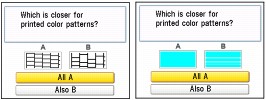
- For (A) (no missing lines or no horizontal white streaks) in (1) and (2):
Select [All A] and press the <OK> button.
The cleaning is not required.
The screen returns to the Maintenance screen.
- For (B) (lines are missing or horizontal white streaks are present) in (1) or (2):
- Select [Also B] and press the <OK> button.
Clean the Print Head. The cleaning confirmation screen appears.
- Select [Yes] and press the <OK> button.
The machine starts cleaning the Print Head.